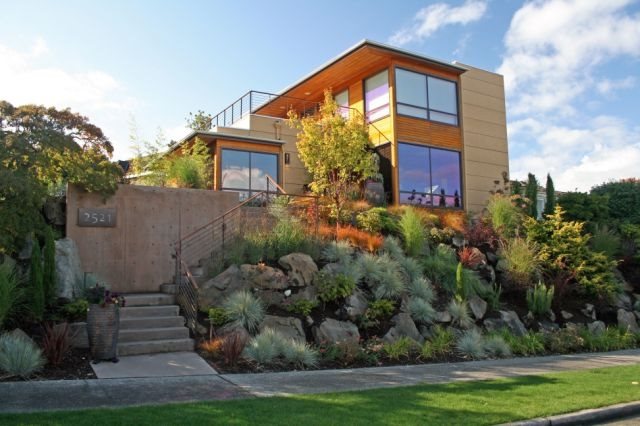Simple techniques to improve Steep hill landscaping with minimal effort.
Simple techniques to improve Steep hill landscaping with minimal effort.
Blog Article
Achieve a Beautiful Exterior Sanctuary With Thoughtful Steep Hillside Landscape Design Solutions
Changing a steep hill into a fascinating outside oasis offers one-of-a-kind obstacles that need innovative landscape design remedies. By addressing issues such as disintegration control and access, one can develop an unified blend of appeal and functionality. Techniques such as terracing, the installment of keeping walls, and the choice of native plants play crucial roles in this procedure. Additionally, integrating water attributes can even more improve the landscape's appeal. Understanding the intricacies of these components is vital for attaining a truly cohesive and inviting atmosphere. What approaches will best suit your hill's specific characteristics?
Understanding Steep Hillside Obstacles
Landscape design on high hillsides presents special challenges that require careful consideration and strategic preparation. The disposition of the terrain can cause concerns such as dirt disintegration, water overflow, and limited accessibility, all of which need to be resolved to develop a functional and visually pleasing outside space.
Among the primary interest in steep hillside landscaping is erosion, which can result from hefty rains or improper water drainage. This not only impacts plant wellness yet can additionally jeopardize the stability of the incline. Applying effective disintegration control steps, such as planting ingrained vegetation or using compost, is essential in preserving the honesty of the landscape.

Creating With Terracing Methods
To alleviate the challenges presented by high hillsides, incorporating terracing techniques can be an effective remedy. This design approach transforms a sloped landscape into a series of level, level locations, producing an aesthetically striking and functional outside room. Terracing not only assists to stop dirt erosion yet additionally promotes far better water drain, which is essential in preserving the health of plants and the stability of the hillside.
When developing balconies, mindful consideration of the slope's angle and the dirt kind is necessary. Each balcony ought to be tactically put to take full advantage of sunlight exposure while reducing the threat of runoff. Making use of indigenous plants on each level can boost biodiversity, advertise sustainability, and reduce upkeep demands. In addition, incorporating paths in between terraces can improve availability and urge expedition of the landscape.
Terraced gardens can serve multiple purposes, including vegetable manufacturing, ornamental displays, or outside seating areas. By utilizing materials that mix sympathetically with the surrounding environment, the terracing can improve the general aesthetic appeal of the home. Ultimately, thoughtful terracing transforms steep hills into useful, stunning spaces that welcome communication and satisfaction.
Implementing Keeping Walls
When confronted with the obstacles of important source high terrain, carrying out keeping wall surfaces can provide both architectural support and visual improvement to a landscape. These wall surfaces offer to stop soil disintegration, maintain inclines, and develop level areas for horticulture or entertainment usage. Steep hill landscaping. By successfully handling water drainage and lowering dirt motion, maintaining walls shield your landscape investment while improving safety and security

Specialist setup is important to ensure the durability and performance of keeping walls. Correct water drainage systems need to be integrated to soothe hydrostatic pressure, stopping architectural failing. Consulting with landscape specialists will make sure that the style aligns with your total vision while sticking to local laws.
Finding Indigenous Plants
Picking native plants for your landscape design supplies many eco-friendly and visual advantages. Steep hill landscaping. Native plants are adjusted to the neighborhood environment and soil conditions, needing less water and maintenance compared to non-native varieties. This adaptability not just saves sources yet likewise promotes a much healthier environment, as native plants support regional wildlife, including pollinators such as bees and butterflies
Including native plants right into your steep hill landscape design can boost soil stability, reducing disintegration and promoting a balanced ecological community. visit this web-site Ingrained indigenous plants help anchor the dirt, making them perfect for sloped locations. Additionally, these plants commonly exhibit dynamic colors and varied textures, creating a visually attractive landscape that balances with the surrounding environment.
When picking indigenous plants, consider their growth practices, seasonal passion, and compatibility with other species. Organizing plants with comparable water and sunlight requirements can result in a more cohesive design, while additionally streamlining upkeep. By selecting indigenous plants, you not just grow a sustainable exterior sanctuary but additionally add favorably to the local biodiversity, making sure that your landscape prospers for several years to find.
Incorporating Water Features
Integrating water attributes right into your high hill landscape design can dramatically boost both the aesthetic charm and environmental performance of the area. The sound of flowing water produces a tranquil ambience, while visually, it can work as a centerpiece that attracts the eye and includes deepness to the landscape.
When selecting water features, consider choices that match the natural contours of your hillside. Waterfalls, as an example, can cascade the slope, creating visual rate of interest and advertising healthy and balanced drain. Ponds can also be integrated into the style, motivating neighborhood wildlife and offering habitats for numerous types.
In addition, the placement of plants around these functions is critical. Native aquatic plants not just boost the elegance of the water function yet additionally add to its environmental balance by filtering pollutants and supplying food for regional animals.
Upkeep is an additional essential factor; make sure that your water function is made for easy upkeep. An effectively created function will need minimal treatment, enabling you to enjoy the charm and peace it uses without too much labor. Ultimately, thoughtfully incorporated water features can transform your steep hillside landscape right into a captivating outside oasis.
Final Thought
In final thought, changing a high hill into an attractive outside oasis demands from this source thoughtful landscape design approaches that resolve disintegration control and accessibility. The combination of terracing methods, the implementation of maintaining walls, and the selection of native plants are important elements of effective style.
Report this page